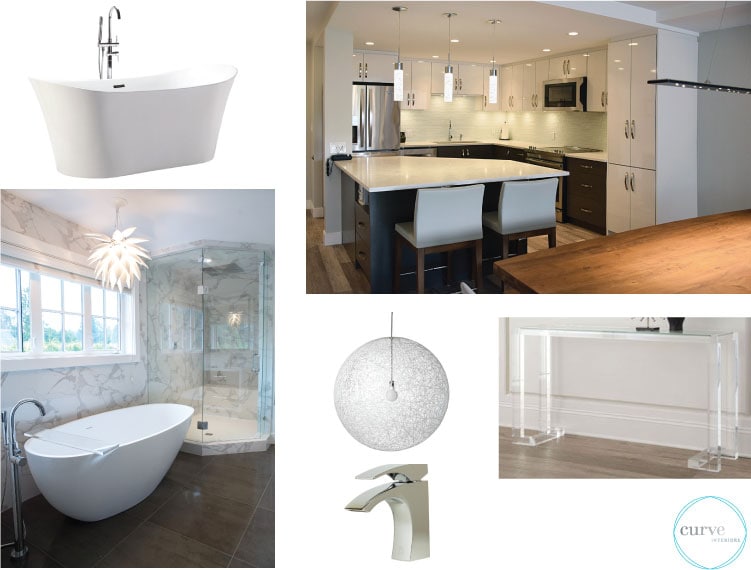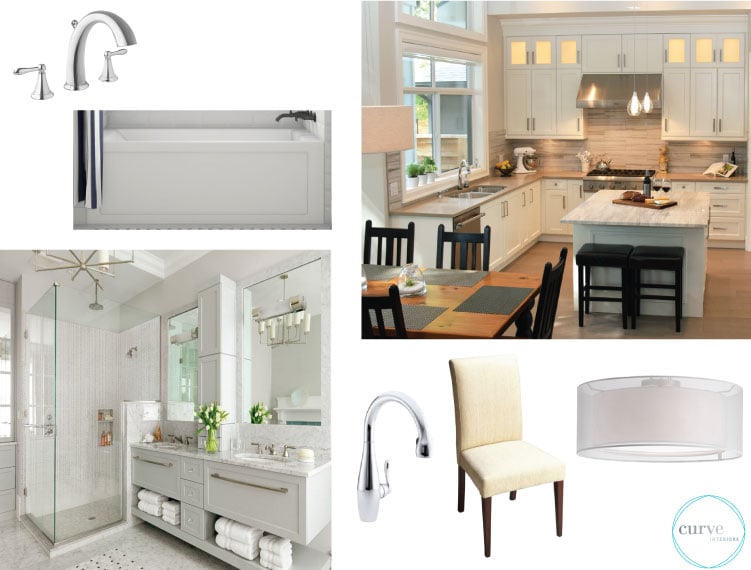Interior design trends can be broken into four basic categories: traditional, contemporary, and transitional. In this post, we’ll explain the unique characteristics of the three most common design styles.
Traditional Interior Design Trends

Louis XV French Settee//Draper Chest of Drawers//Etched Glass Pendant//Gold Pendant//Kitchen Faucet//Kitchen Image Courtesy of Jan Gleysteen//Bathroom Image Courtesy of JCA Architects
Traditional decor has shined for so long because of the comfort it brings to a home. Every piece adds character, telling a story. The key is to create a lived in space without being overly fussy.
Symmetry & balance are very important. Focus on layering 2 to 3 accents together, such as throw pillows on a sofa to create an inviting atmosphere. A soft colour palette mixed with rich wood tones creates a fresh bold statement. Patterns like florals, plaids, paisley and stripes are a must with this style but don’t go overboard. Add a bit of sparkle as the ultimate finishing touch.
Contemporary Interior Design Trends

Free Standing Tub//Bathroom Faucet//Moooi Pendant//Acrylic Console Table//Kitchen Image Curve Interiors – Moberly Rd//Bathroom Image Curve Interiors – Chancellor Blvd
Any design that is current and trendy is considered contemporary. This is a look that embodies linear design while playing with scale and texture to create a fun yet clean space.
The key to contemporary design is sophistication. Focus on minimal design elements, less is more! An open space layout are the ground rules in contemporary décor, the more natural light you have the better. Incorporate textured items and simple geometric forms to add structure to a space. A neutral colour palette, either warm or cool is a great foundation for creating a contemporary space. A pop of colour can add energy but in small quantities, such as a stool, abstract painting or a feature wall.
Transitional Interior Design Trends

Alcove Tub//Grohe Bathroom Faucet//Kohler Kitchen Faucet//Kuzco Flush Mount//Parsons Dining Chair//Kitchen Image Curve Interiors – Pebble Hill Residence//Bathroom Image Courtesy of Castle Design
Transitional design blends the warmth of traditional decorating with the clean lines of contemporary design, giving you a casual yet tailored look.
Transitional design brings harmony to a home with monochromatic schemes and tone on tone palettes. However, make sure to layer different textures and scales to add depth to your space. When furnishing, look for pieces that feel inviting and comfy yet have a defined profile. Panelled cabinetry with simple hardware work well in this design. Remember, a successful transitional space exudes peace, relaxation and comfort.